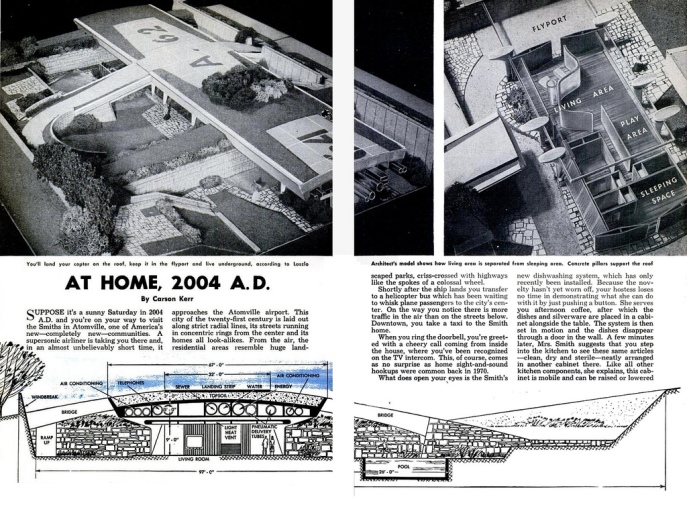Month: January 2017
Paul László: The Quintessential Atomic Age Architectural Designer
StandardPaul László was a Hungarian-born modern architect and interior designer whose work spanned eight decades and many countries. László built his reputation while designing interiors for houses, but in the 1960s, largely shifted his focus to the design of retail and commercial interiors. – wikipedia
László was the quintessential Atomic Age mid-century designer. In 1952 TIME magazine called him ‘The Rich Man’s Architect’. He did it all – he ‘design[ed] his houses down to the last ashtray or built-in Kleenex holder.’ He also designed a rather mod US Air Force bomb shelter:

Laszlo US Air Force Bomb Shelter Design (image via orhan ayyuce)
Below are some super articles covering Paul Laszlo’s Atomic Age masterpieces. Super thanks to MidCentArc on flickr. (Click on the images for a larger view)

Atomville – At Home, 2004 A.D. – 1954 (Page 1 of 3) – Architect: Paul Laszlo (Popular Mechanics Magazine)
Paul Laszlo was truly a Mid-Century visionary – if you could afford him.
AMERICAN MUSEUM OF ATOMIC ENERGY
StandardSpecial Thanks To: Todd Franklin

Hey kids! Pull up your bobby socks and get ready to duck and cover ’cause we’re visiting the American Museum of Atomic Energy! I’m sure you’ve heard about that little project during WWII called the Manhattan Project, right? You know, atomic bombs and such. The souvenir beanie above is telling the truth when it says, “Oak Ridge, Tennessee is the home of the atomic bomb. This “secret city” sprouted up during the war years and in its factories the atomic bomb was built. After the war, the town shifted to civilian control.

In 1949, Oak Ridge also became the home of the American Museum of Atomic Energy! This was the place to learn about the benefits of the all powerful atom. More importantly, it was the place where you could get a radioactive dime to take home as a souvenir!

In the brochure pictured above, it looks like those teenagers are having fun feeding the machine dimes. Boy, that sure beats getting a wooden nickel for a souvenir!

Unfortunately, the dime didn’t glow like my exaggerated example, but that’s how I like to imagine it when it came out of the machine. In reality, the radiation faded away quickly and the dime was supposedly safe to stick in your pocket. (Click here for more info on irradiated dimes and here for another photo.)
The museum was much more than radioactive dimes according to these excerpts from the brochure.


The Dagwood Splits the Atom exhibit looks like fun! Science is always better when explained by comic characters. Apparently this exhibit made the rounds to various fairs and museums. Click here and here to view the official comic.

Here you get to see a schematic model of plants that helped build the atomic bomb.

The first gas diffusion separation is on display. (You know, I really don’t know what any of this means, but it sure does sound interesting!

The Theatre of the Atom. I think this is where an audience member would get their hair zapped. Click here to see this gal get a new atomic hairdo!

The American Museum of Atomic Energy moved to a new location in 1975 and in 1978 the name was changed to American Museum of Science and Energy. Even though they don’t have a dime irradiator machine the place still looks like a fun family outing.
I leave with you this very cool photo of a vintage bowling shirt from Oak Ridge. I snapped this pic at the Bowling Hall of Fame back when it was located in St. Louis, Missouri.

If an A-Bomb Falls… Will You Know What to Do?
Standard
If An A-Bomb Falls was an 8-page Instructional comic published in 1951 (see comic pages below). It is in the public domain and can also be viewed on-line at various sites like Archive.org. Summary from My Comic Shop: “If an A Bomb Falls… Will You Know What to Do? (1951), published by Commercial Comics. 8 pages, full color, standard comic book dimensions, all newsprint, no cover price. This promotional educational giveaway comic book describes what to do in the event of an atomic blast. Includes: 1) How important it is to know the signals of an impending atomic attack; 2) The meaning of the different tones of air raid sirens; 3) What to do if you are attacked without warning ; 4) How to react to the brilliant flash of an atomic explosion; 5) How to find the safest place in your home; 6) The equipment you need for a home safety and emergency kit; 7) How to store a good supply of canned goods and water for extended sheltering; 8) How to prepare for an attack if you have advance warning How to seek protection from an impending attack; 9) Remembering to keep calm to stifle panic during an attack ; 10) How people caught outdoors will suffer the greatest casualties; 11) What to do if you are on a car, bus, or train during an attack; 12) How the worst danger from atomic attack is radiation in the air and water; and 13) How to decontaminate yourself if you think you have been exposed to radioactive dust or mist. The back cover features a chart showing the number of deaths and the number of injured people that can be projected if an A-bomb explodes in a populated area.” Additional pages below from Ethan Persoff.


The H-Bomb and You was an educational 16-page comic published by the government in 1954. Page #1 reproduced below from Ethan Persoff. We’ll take a closer look at what these educational comics tell us about the era in the future.





